In-Depth Guide to Howard Rotavator Tines
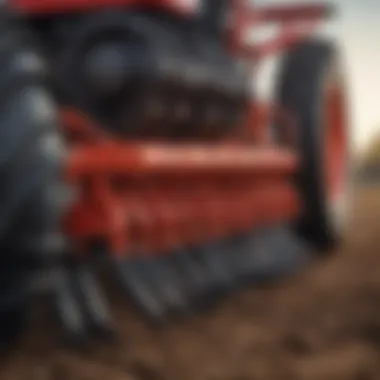

Intro
In the world of agriculture, tools that facilitate soil management play a crucial role in the success of any farming operation. Among these tools, Howard rotavator tines stand out. They are not just mere attachments; they are essential components that contribute significantly to effective soil cultivation, aiding in preparing the land for crops and maintaining a healthy growing environment. Understanding the intricacies of these tines can lead farmers and agricultural enthusiasts to make better informed decisions that enhance productivity and sustainability.
Overview of the Topic
Definition and Importance
Howard rotavator tines are sharp, curved metal implements attached to rotavators, a type of mechanical tillage equipment. These tines dig into the soil, breaking it up, aerating it, and turning it over, which helps to incorporate nutrients, manage weeds, and prepare land for planting. The strategic use of rotavator tines can significantly impact soil structure, water retention, and ultimately the health of crops. Farmers who grasp the importance of these tools can optimize their use, resulting in improved crop yields.
Current Trends
In recent years, there has been a growing emphasis on precision farming techniques. This includes the detailed analysis of soil health and the targeted application of tines based on specific soil conditions. Additionally, there's an increased focus on using tines that minimize soil disturbance, aligning with sustainable farming practices. As technology advances, farmers are also adopting innovations such as variable-rate tilling, which allows them to adjust the depth and intensity of tine operation based on real-time data.
Key Techniques and Practices
Step-by-Step Guide
To effectively utilize Howard rotavator tines, follow these steps:
- Assess Soil Conditions: Before beginning, examine your soil. Look for compaction, moisture levels, and nutrient content.
- Select the Right Tines: Depending on your specific needs, choose tines designed for certain tasks, such as shallow or deep loosening.
- Adjust Tine Depth: Proper depth settings are crucial. Make adjustments based on the soil type and the crop being planted.
- Begin Tilling: Start the rotavator, allowing the tines to engage with the soil. Keep an eye on the machine’s performance, and make adjustments as necessary.
- Follow Up: After tilling, evaluate the soil texture and structure. Assess whether additional passes are needed or if any changes should be made.
Tools and Equipment Needed
Implementing a successful tilling operation requires more than just the tines themselves. Consider the following tools:
- Rotavator: Make sure it is compatible with your tines.
- Soil Moisture Meter: Helps gauge moisture levels before tilling.
- Calibration Tools: Ensures your machinery is operating at peak efficiency.
Challenges and Solutions
Common Obstacles
While Howard rotavator tines are effective, farmers may face challenges like:
- Soil Compaction: Using the wrong tine type can lead to further compaction rather than alleviating it.
- Wear and Tear: Regular use can wear down tines, requiring frequent replacements.
- Variable Soil Conditions: Different fields may present varying challenges in terms of soil types and conditions, complicating tillage efforts.
Innovative Solutions
To address these challenges, consider the following solutions:
- Variable Tine Options: Invest in a set of tines catering to different soil types and conditions.
- Regular Maintenance: Conduct periodic checks on the tines for wear and replace them as needed to ensure optimal performance.
- Data Collection: Use soil analysis tools to gather data that can help in choosing the right tines and settings for each specific field.
"Understanding the nuances of soil through effective use of rotavator tines is not just beneficial; it's vital for sustainable crop production and soil health."
Prologue to Howard Rotavators
Howard rotavators hold a pivotal role in modern agriculture, transforming the way we think about soil preparation. These machines are not just large tools; they are essential pieces of equipment that help farmers cultivate the land efficiently, ensuring that crops can thrive. In agricultural practices, the condition of the soil often dictates the success of the harvest. Therefore, understanding the mechanics behind Howard rotavators, particularly their tines, can greatly influence the yield that farmers can expect.
By incorporating Howard rotavators into their routines, farmers increase their ability to manage soil structure effectively. Good soil management can lead to better aeration, enhanced moisture retention, and ultimately, healthier plants. This section introduces the significance of rotavators in the agricultural process and lays the groundwork for a discussion on tines, which are key components of these machines that significantly impact soil preparation.
Overview of Rotavators
Rotavators are versatile machines equipped with rotating blades known as tines, which dig into the soil to break it up and prepare it for planting. This process is crucial for creating a suitable environment for crop growth. The design and efficiency of these machines have evolved over time, enabling farmers to cover larger areas in a shorter span, which is especially important in commercial farming.
For example, using a modern Howard rotavator, a farmer can prepare a field in a matter of hours that might have taken days with traditional methods. Not only does this save time, but it also minimizes labor costs, making farming more economically viable.
In the heart of every successful rotavator lies its tines. Understanding how tines function, their design variations, and their applications is fundamental for farmers looking to get the most out of their equipment. This complexity in tines not only affects soil management but also impacts overall crop productivity, which is a central concern for any agricultural undertaking.
Historical Context
The evolution of rotavators parallels that of agriculture itself. The necessity for effective soil preparation has been recognized for centuries, but the introduction of mechanized methods marked a significant turning point. Early farming tools were rudimentary—think wooden plows drawn by oxen, which provided limited efficiency and required a substantial amount of labor.
As technological advancements began to emerge in the 19th century, the first mechanical rotavators started appearing. However, it wasn't until the mid-20th century that Howard rotavators gained recognition for their reliable and efficient performance in the field. Farmers transitioned from traditional methods to these machines for various reasons: labor shortages, the rising cost of labor, and the need for increased productivity.
Today, Howard rotavators are synonymous with modern farming practices. Their development reflects a broader shift in agricultural techniques, focusing on efficiency, sustainability, and productivity. Knowledge of this historical context helps to appreciate the current capabilities and importance of rotavator tines in enhancing agricultural outcomes.
"Understanding the historical backdrop of Howard rotavators underscores the relentless quest for tools that maximize the efficiency of farming processes, leading to the crops on our plates today."
In summary, the introduction to Howard rotavators and their importance paves the way for deeper discussions about the role of tines in soil preparation. A grasp of the mechanics and history offers a full picture of their relevance in today's agricultural landscape.
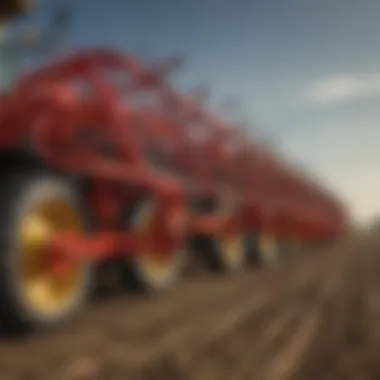

The Role of Tines in Soil Preparation
Soil preparation is a crucial part of agriculture, and understanding the role that tines play can make a significant difference in how effectively this process is executed. Tines are not just simple attachments; they are the unsung heroes of the rotavator that actively engage with the soil, making it friable and ready for planting. When one considers the various factors that influence soil health and crop productivity, the functionality of tines becomes apparent. They are designed to break up the soil, mix in nutrients, and improve aeration. Consequently, this enhances water infiltration and root development.
Understanding Tine Functionality
The primary function of tines in soil preparation revolves around their ability to fracture and aerate the soil structure. When tines penetrate the earth, they create channels that allow air and moisture to reach plant roots without compacting the soil further. Think of tines as the fingers of a gardener gently tilting the earth, each tine separating the soil like points on a fork.
- Soil Fracturing: Tines disrupt hardpan layers and compacted soil zones, fostering an environment where roots can stretch and grow.
- Aeration: By loosening the soil, tines enhance oxygen levels, which are vital for root metabolism and overall plant health.
- Nutrient Mixing: As tines turn over the soil, they facilitate the incorporation of organic matter and fertilizers, ensuring that nutrients are evenly distributed.
In essence, the effectiveness of a rotavator hinges on how well its tines perform these crucial tasks. Their design, angle, and spacing all contribute significantly to their ability to modify the soil structure. When selecting a rotavator, it's prudent to prioritize the quality and type of tines to match the specific needs of your soil type.
Types of Tines and Their Uses
Different soil conditions necessitate different types of tines, and selecting the appropriate type can be the difference between a bountiful harvest and moderate yield.
- Fixed Tines: These are the standard, no-frills option that provide durability. They are suitable for general soil preparation tasks but might lack flexibility when tackling varied soil types.
- Replaceable Tines: This type allows for easy swapping, which means you can adapt your rotavator to different soil conditions without needing a complete overhaul. Ideal for farmers who wish to maximize versatility in their equipment.
- Serrated vs. Non-Serrated Tines:
- Serrated tines have cutting edges that excel at tackling tougher, more compact soils. Their sharp design allows for better penetration, which is important when managing clay-heavy ground.
- Non-serrated tines tend to be gentler on the soil and are perfect when the goal is to mix light, sandy soils or to incorporate organic matter without overworking the land.
Choosing the right tines goes beyond just functionality. It’s about matching the specific needs of your agricultural practices and ensuring your rotavator performs efficiently through effective soil preparation. Understanding the nuances of tine usage will empower farmers to leverage their equipment to its fullest potential.
"The right tines can transform the performance of your rotavator, leading to healthier soil and explosive crop success."
Different Types of Howard Rotavator Tines
When it comes to soil cultivation, understanding the different types of Howard rotavator tines can significantly enhance a farmer's ability to manage their land effectively. Each tine type comes with its specific design and function, tailored to address various soil conditions and agricultural needs. This section aims to elucidate those differences, ensuring farmers and enthusiasts can make informed decisions that lead to improved soil health and crop yield.
Fixed Tines
Fixed tines are typically made from a solid piece of metal, offering durability and strength for extensive soil preparation tasks. Their design allows them to penetrate the ground deeply, breaking up hardpan soil layers effectively. These tines are particularly useful in heavy soils or fields that have not been cultivated for a while. Fixed tines can provide certain stability, allowing for precise control when tilling.
However, there are considerations. While they are durable, fixed tines lack flexibility. Once installed, they cannot be replaced with different shapes or sizes to tackle varied tasks throughout the growing season. Thus, understanding the specific farming context is key before opting for fixed tines.
Replaceable Tines
Replaceable tines present a versatile option for the modern farmer. As the name suggests, these tines can be swapped out as needed based on various soil types or changing agricultural needs. For instance, if a farmer moves from working in clay soil to sandy loam, switching out the tines can optimize their machinery's performance.
"The ability to tailor your equipment to the soil not only boosts efficiency but also reduces wear and tear on the machinery itself."
These tines often come in a variety of materials and shapes, from hardened steel for longevity to specialized designs aimed at specific soil conditions. While it’s helpful to have a full set of replaceable tines on hand, this option does require a slightly higher upfront investment and thoughtful maintenance practices to ensure they remain in top condition.
Serrated vs. Non-Serrated Tines
The debate between serrated and non-serrated tines is one of the more nuanced decisions faced by those using Howard rotavators. Serrated tines have teeth-like edges that can significantly enhance their cutting ability, making them ideal for breaking up stubborn soil or chopping through residual crop material remaining on the surface. This can be particularly advantageous in organic farming methods, where integrating cover crops into the soil is a common practice.
In contrast, non-serrated tines offer a smoother, broader surface, which can be beneficial for lighter tillage tasks or for creating a finer seedbed. They tend to leave the soil structure intact, which is advantageous for maintaining soil health.
Choosing between the two depends on multiple factors:
- Soil Condition: Consider what type of soil you are working with.
- Crops Grown: Different crops might require different soil treatments.
- Desired Soil Health: Some tines may disturb soil health less than others.
Both serrated and non-serrated tines bring unique advantages and challenges. By carefully assessing these aspects, agricultural professionals can optimize their tools, ensuring that their farm's needs are met efficiently.
Selecting the Right Tine for Your Soil Type
Selecting the correct tine for specific soil types is crucial in achieving optimal agricultural outcomes. The right tine not only affects how efficiently the rotavator operates but also has significant implications for soil health, crop productivity, and sustainability.
Understanding the nuances of various soil conditions and how they interact with different tines can make a wold of difference in farming practices. Farmers who take the time to align their tines with their soil can expect to see enhanced performance and productivity, ultimately leading to a more profitable yield.
Analysis of Soil Composition
Soil isn’t just dirt; it is a living entity comprising minerals, organic matter, water, and air. When assessing soil composition, it's important to recognize three primary components: sand, silt, and clay.
- Sand: This tends to provide good drainage but may lack nutrients.
- Silt: Holds moisture and provides nutrients effectively but may lead to compaction if not managed.
- Clay: Excellent at retaining moisture and nutrients yet can become compacted and hard to work with.
By identifying the proportion of these components, farmers can better understand their soil's behavior. For instance, clay soils may necessitate tines that can effectively break up hardpan layers, while sandy soils might benefit from tines designed for aeration without excessive soil disturbance.
Matching Tines to Soil Conditions
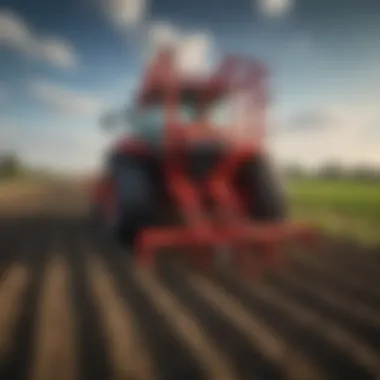
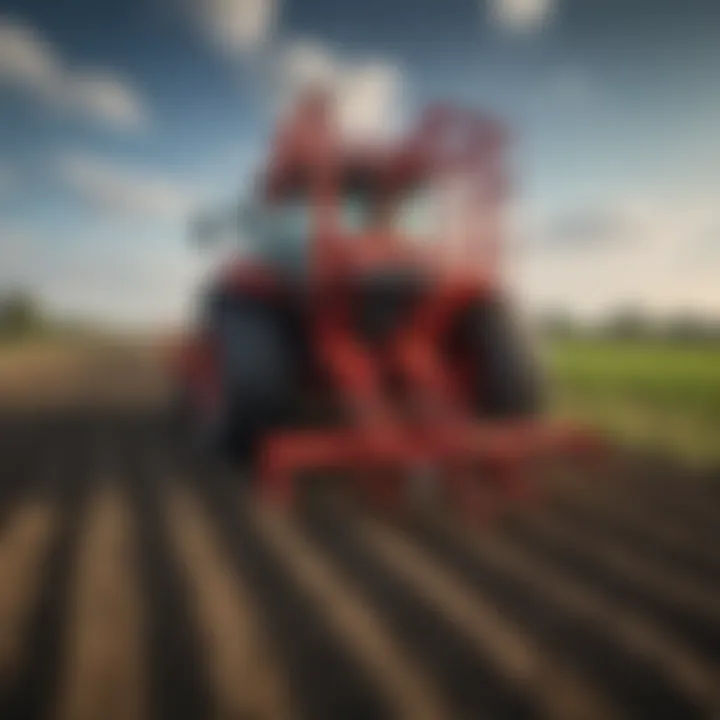
The choice of tines is also about more than just soil type; it’s about specific conditions and what a farmer aims to achieve. Here’s a snapshot of considerations to keep in mind:
- Soil Texture: Tines need to match the texture, as different soil types react uniquely to tilling. For instance, in sandy soils, non-serrated tines may suffice, while clay soils often require serrated tines for better penetration.
- Moisture Content: The wetter the soil, the more likely the tines will stick to the ground. A tine that slices through dry soil might struggle in wet conditions.
- Crop Type: Certain crops benefit from specific tine activities. For instance, deep tillage may help root vegetables thrive by loosening compacted layers.
- Seasonality: Depending on the time of year, soil conditions change. What worked in the spring may be ineffective in autumn due to varying moisture levels or crop residue.
"Understanding your soil is like deciphering a language; once you grasp the basics, the rest flows much more smoothly."
By taking these factors into account, farmers can avoid unnecessary labor and enhance their soil’s health, nurturing their crop growth in a sustainable manner. Selecting the right tine isn’t just a choice; it’s a strategy that fosters long-term success in agriculture.
Impact of Tines on Soil Health
The role of rotavator tines stretches far beyond mere soil disturbance; they are pivotal in shaping the overall health of the soil. By understanding how tines impact soil conditions, farmers can appreciate their significance in agronomy. Essentially, these tines help in creating a robust ecosystem within the soil, enabling better crop performance and sustainability.
Soil Aeration and Structure
Soil aeration is an often-overlooked yet crucial aspect of soil health. Tines break up compacted soil, allowing air to penetrate deeper layers. This aeration promotes the exchange of gases, essential for root respiration. If the soil resembles a brick, plant roots struggle to grow. The functionality of tines in this regard cannot be underestimated. When properly used, tines create channels in the soil which allow water to infiltrate more efficiently, leading to improved moisture retention.
In practical terms, well-aerated soil leads to healthier crops. A study showed that crops grown in well-aerated environments produce yields significantly higher than those in compacted soils. This outcome results from better access to nutrients and water. Farmers often notice the difference in plant vigor and growth rates after using tines for aeration purposes.
In addition to allowing roots to breathe, tines also contribute to the soil structure. Structured soil helps prevent erosion, enables better root growth, and leads to a more balanced ecosystem where beneficial microorganisms thrive. The diverse interactions between the soil texture and the tines can determine the soil's ability to support life above and below the ground.
Contributing to Sustainable Practices
Sustainability in agriculture is more than a buzzword; it's becoming a necessity. Using Howard rotavator tines promotes sustainable farming practices, contributing to long-term soil health. Tines enable farmers to adopt reduced tillage methods, which are essential in conserving soil moisture and organic matter.
The integration of tines allows for the following sustainable practices:
- Minimized Soil Disturbance: By opting for tines that create minimal disturbance, farmers can maintain soil structure, which is critical for soil fertility.
- Improved Water Management: Enhanced aeration helps retain moisture, reducing the need for excessive watering. This aspect is particularly valuable in drought-prone areas.
- Promotion of Biodiversity: Healthy soil supports a rich ecosystem. The effectiveness of tines in mixing organic matter into the soil fosters a healthier habitat for earthworms and beneficial insects, which further improves soil quality.
"Utilizing the right tines effectively can be a game changer for sustainable farming practices."
In essence, being mindful of the tools one uses can lead to a more balanced relationship with the environment. Hence, ensuring proper use and maintenance of tines becomes critical in adopting sustainable agricultural practices.
By understanding how tines affect soil health, farmers can not only improve productivity but also cultivate a more sustainable approach to agriculture.
Maintenance and Care of Howard Rotavator Tines
Keeping your Howard rotavator tines in top-notch condition is more than just a good idea; it’s a crucial practice that can significantly impact performance in the field. Neglecting them can lead to subpar soil preparation, which ultimately affects crop yield. By focusing on maintenance, farmers can ensure their investment lasts longer and operates efficiently.
Routine Maintenance Practices
Regular upkeep of tines involves several straightforward yet effective practices:
- Cleaning: After each use, make it a habit to clean the tines thoroughly. This helps prevent soil buildup and corrosion, which can diminish effectiveness over time.
- Lubrication: Periodically greasing moving parts is essential. It reduces friction and wear between components, allowing for smoother operation.
- Inspection: Conducting regular checks for any signs of damage or wear can catch potential issues before they escalate. Look for cracks, deformation, or any irregularities that could hamper performance.
- Storage: When not in use, store the rotavator in a clean, dry place. Using a cover can keep moisture at bay and prevent rust.
Implementing these practices can save time and money in the long run, ensuring that your tines are ready for work when you are.
Identifying Wear and Tear
Recognizing wear and tear early can extend the life of your rotavator tines. Here are some tell-tale signs:
- Uneven Cutting Edge: If you notice that the tines aren’t cutting evenly, it’s a strong indicator they’re wearing out. This can lead to poor soil structure and inadequate mixing.
- Corrosion: Look for rust spots or other signs of corrosion, especially if the tines are made of softer metals. Corrosion can significantly weaken the material and affect performance.
- Excessive Bending or Warping: If any tines appear bent or warped, they might not function effectively anymore. Inspect them closely for structural integrity.
- Vibration or Noise: If your rotavator starts vibrating excessively or making unusual noises during operation, it might signify something wrong with the tines.
"An ounce of prevention is worth a pound of cure." Taking time to maintain and inspect your tines can prevent small issues from developing into larger, more costly ones.
Advantages of Using Howard Rotavator Tines
Howard rotavator tines play a pivotal role in modern agriculture, mainly due to their efficiency in preparing soil for cultivation. This segment of the article digs into the specific advantages these tines provide and explains how they are crucial to farming practices, enhancing both yields and the effectiveness of farmers’ efforts.
Enhancing Crop Growth
When discussing the benefits of Howard rotavator tines, enhancing crop growth emerges as a fundamental point. Tines work by breaking up the soil, allowing air, water, and essential nutrients to penetrate deeper into the ground. This process not only facilitates root expansion but also supports the development of a healthier plant system.
Consider, for instance, a farmer dealing with compacted soil. The action of the rotavator tines helps to alleviate this issue, enabling better water drainage and reducing the likelihood of root rot. As plants receive better access to water and nutrients, you’ll often see an increase in crop yields. This pull toward healthier, thriving crops is what makes these tines indispensable.
Notably, the versatility of tines is beneficial too. Specialized designs like serrated tines can help in different soil conditions, allowing for tailored cultivation. Each time these tines enter the soil, they perform the important task of aeration efficiently. A well-aerated soil promotes strong microbial activity, further boosting plant growth.
Efficiency in Time and Labor
In the fast-paced world of agriculture, time and labor efficiency means everything. Howard rotavator tines contribute significantly to this aspect. Using these tines can turn a time-consuming job into a much quicker process, which is vital during planting seasons when every minute counts.
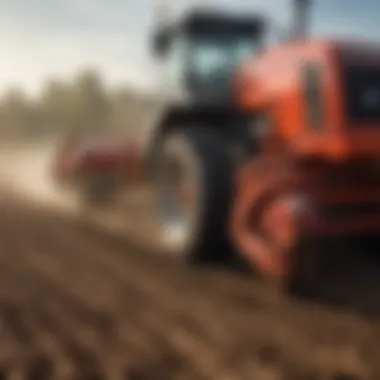
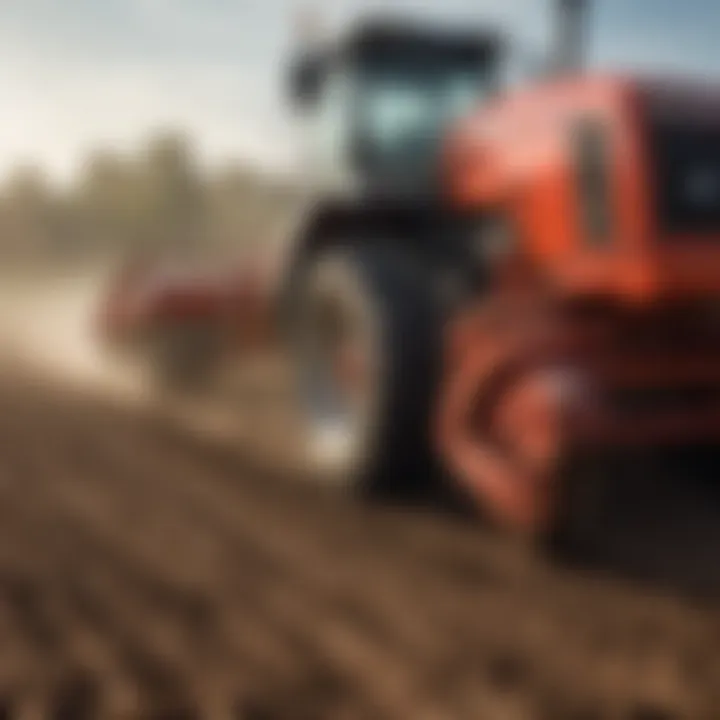
Farmers can cover more ground in a shorter time frame compared to traditional tillage methods—this is attributable to the design of rotavators that allow for multiple tines to work in unison. Additionally, the ease of use of these machines means less manpower is needed. So a farmer can operate the rotavator solo where they might have needed a crew before.
"The right tools can make all the difference; Howard rotavator tines bring efficiency right to the field."
As a result, farmers not only save on labor costs, but they also gain precious time to focus on other crucial tasks in the farming cycle. With the convenience these tines provide, it’s clear why investing in Howard rotavator tines can be a game changer for a farming operation looking to maximize productivity.
These advantages underscore the essential role of Howard rotavator tines in contemporary agriculture, paving the way for increased crop productivity and efficient operational practices.
Common Challenges with Rotavator Tines
When considering how tines function, it's important to address the common challenges faced with rotavator tines. These challenges can significantly impact both the efficiency of the rotavator and the overall success of soil management practices. Understanding these issues not only helps in troubleshooting but also in optimizing the performance of the equipment for better crop production.
Soil Compaction Issues
Soil compaction stands as a major hurdle in effective agriculture. When soil becomes compacted, air, water, and nutrients struggle to permeate the ground. This adversely affects root growth and decreases moisture retention. Tines play a crucial role here; their ability to break up compacted soil makes them indispensable in soil preparation processes.
Farmers often confront two principal types of soil compaction:
- Surface compaction, typically caused by machinery traffic, which creates hard layers on the top soil.
- Sub-surface compaction, which occurs deeper and is usually a result of repeated tillage or heavy equipment use.
To tackle these compaction problems, consider using tines that are specially designed to penetrate deeply and break up hard layers. Serrated tines, for instance, can be effective in slicing through tough soil, loosening it for further cultivation. It's essential to monitor the performance of these tines routinely, as worn edges can lead to limited effectiveness in addressing soil compaction.
“Addressing soil compaction challenges not only helps in improving root penetration but can also lead to better water retention and nutrient availability.”
Managing Different Soil Types
Every patch of land presents unique soil conditions, and managing those variations efficiently is another substantial challenge in the use of rotavator tines. Not all tines work equally well in every soil type. For instance, clay soils typically require different tine characteristics than sandy soils.
To navigate these differences successfully, farmers should:
- Evaluate soil texture—knowing whether the soil is sandy, loamy, or clayey can guide tine choice.
- Choose the right tine—fixed tines might work well in loose soils, while replaceable or serrated tines could be necessary in tougher, more compact soils.
In addition, adjusting the depth of operation based on soil type is vital. In lighter, sandy soils, tines can often operate at greater depths without much difficulty. In contrast, heavier, clay soils might necessitate a shallower depth to avoid excessive resistance.
Addressing these soil variances not only boosts the effectiveness of the rotavator but also plays a big part in encouraging healthy soil conditions and optimal crop yields. Understanding the specific requirements of each soil type can turn a standard rotavator operation into a more tailored and successful agricultural strategy.
Future Trends in Tine Technology
In the rapidly evolving world of agriculture, the future of rotavator tines stands as a beacon of innovation. Understanding these trends is crucial for farmers and agricultural professionals looking to stay ahead of the game. With increasing demands for sustainable practices and greater efficiency in farming operations, these advancements present both opportunities and considerations worth noting.
Innovations in Design
The design of rotavator tines is experiencing a notable transformation. Gone are the days when simplicity ruled. Today, engineers and designers are focusing on developing tines that are not only effective but also tailored to specific soil conditions and farming methods. Innovations include materials that enhance durability and reduce wear and tear. For instance, some manufacturers are experimenting with high-grade steel alloys or composite materials that offer superior strength and longer life spans.
Additionally, ergonomic designs are becoming commonplace. Tines are being crafted to ensure optimal penetration and mixing of soil while minimizing compaction. This means that farmers can work their fields more effectively while using less energy and time.
"With the right tine design, soil preparation becomes less of a chore and more of an efficient process."
Moreover, advancements in technology have led to adjustable tines that can adapt to different soil types right in the field. This flexibility allows farmers to optimize their machinery for varied conditions—from clay to sandy soils—maximizing their tillage effectiveness and reducing the need for multiple equipment setups.
Integration with Automation
The farming industry is gradually shifting towards automation, and this trend extends to rotavator tines as well. Automated systems are integrating with tines to enhance precision and efficiency in land preparation. Think about a rotavator equipped with sensors that can detect soil moisture content and adjust tine depth accordingly. This capability can lead to improved crop health and yield as the soil conditions are catered to more effectively.
Furthermore, drones and robotic technologies are beginning to play a role in monitoring and even operating rotavator equipment. Imagine a scenario where a Farmer can monitor soil conditions from a remote location, prompting their equipment to adjust in real-time. This not only saves on labor but also ensures that resources are used judiciously.
Incorporating automation into rotavator tines can also assist in tracking maintenance schedules, enabling Farmers to address wear and tear before it leads to significant issues. This proactive approach to maintenance is set to revolutionize how farmers manage their equipment, giving them more reliability in their operations.
Overall, the future trends in tine technology reveal an exciting path forward for agricultural practices. From innovative designs that cater to various soil types to automated systems that lend a hand in monitoring and operation, these advancements are positioned to enhance the productivity and sustainability of farming operations, paving the way for a more efficient future.
End
Drawing to a close, the extensive examination of Howard rotavator tines showcases their integral role in modern soil management. Understanding both the functionality and specialized use of these tines leads to remarkable improvements in soil health, which is something every farmer and agronomist should care about. The meticulous selection and maintenance of tines not only enhance productivity but also ensure the sustainability of agricultural practices.
Summary of Key Points
In summary, the article elucidates the different types of Howard rotavator tines, including fixed, replaceable, serrated, and non-serrated varieties. Each type has its unique applications depending on soil conditions, making it vital for users to analyze soil composition before making a choice. Additionally, the discussion highlighted:
- The importance of maintaining the tines for prolonged durability and effectiveness.
- The role of tines in improving soil aeration and preventing compaction, which are crucial for optimal crop growth.
- The current trends in tine technology, focusing on designs that integrate seamlessly with automated systems.
Final Thoughts on Howard Rotavator Tines
"The best soil management starts from the ground up, literally and figuratively. Every choice counts."
Thus, keep in mind that the right tools and knowledge can make all the difference on the farm.



